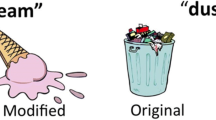Abstract
Using an artificial language system, an attempt was made (1) to examine the effect of relative completeness in describing the reference situations on acquisition of the system and (2) to determine the effectiveness of word order and grammatical markers as syntactic indicators of semantic relations in an opaque partial description situation. The results showed that syntax was induced faster in the mixed description condition, where partial three-word sentences and two-word phrases were given mixed with complete five-word sentences, than in the partial description condition, where only three-word sentences and two-word phrases were given. It was further found that word order was more effective than grammatical markers as a syntactic indicator. It is suggested that language acquisition under partial description conditions is possible provided a sufficient number of experiencing exemplars and/or pragmatic cues as to meaning-form correspondence are given.
Similar content being viewed by others
References
Bever, T. G. (1970). The cognitive basis for linguistic structures. In J. R. Hayes (Ed.),Cognition and the development of language (pp. 279–362). New York: Wiley.
Foss, D. J. (1968). Learning and discovery in the acquisition of structural material: Effects of number of items and their sequence.Journal of Experimental Psychology, 77, 341–344.
Fraser, C., Bellugi, U., & Brown, R. (1963). Control of grammar in imitation, comprehension and production.Journal of Verbal Learning and Verbal Behavior, 2, 121–135.
Hayashi, S. (1976).Nonsensu shiraburu shinkijunhyo. Tokyo: Tokai University Press.
Moeser, S. D., & Bregman, A. S. (1972). The role of reference in the acquisition of a miniature artificial language.Journal of Verbal Learning and Verbal Behavior, 11, 759–769.
Mori, K. (1980a). The effect of mistakes in the input on the acquisition of a miniature artificial language.Japanese Journal of Psychology, 51, 179–187. (In Japanese with English abstract.)
Mori, K. (1980b). The effect of irrelevant factors in the reference field on the acquisition of a miniature artificial language.Japanese Psychological Research, 22, 72–81.
Mori, K. (1981). The effect of mistakes in the input on the acquisition of a miniature artificial language (II): Using a subject-paced procedure.Japanese Psychological Research, 23, 113–117.
Nagata, H. (1976a). Effects of number and irregular forms of exemplars on rule acquisition.Psychologia, 19, 94–101.
Nagata, H. (1976b). Quantitative and qualitative analysis of experience in acquisition of a miniature artificial language.Japanese Psychological Research, 18, 174–182.
Nagata, H. (1977). An experiential condition for creative aspects of morphemic use: Number of experienced exemplars.Psychologia, 20, 64–73.
Nagata, H. (1981). Effectiveness of word order and grammatical markers as syntactic indicators of semantic relations.Journal of Psycholinguistic Research, 10, 471–486.
Nagata, H. (1983a). Effectiveness of word order and grammatical markers as syntactic indicators of semantic relations in opaque input conditions.Journal of Psycholinguistic Research, 12, 157–169.
Nagata, H. (1983b). Richness of input data as a condition of the acquisition of prototypical transitivity in language.American Journal of Psychology, 96, 477–489.
Ochs, E. (1982). Ergativity and word orders in Samoan child language.Language, 58, 646–671.
Ochs, E., & Schieffelin, B. B. (Eds.). (1979).Developmental pragmatics. New York: Academic Press.
Palermo, D. S., & Parrish, M. (1971). Rule acquisition as a function of number and frequency of exemplars presented.Journal of Verbal Learning and Verbal Behavior, 10, 44–51.
Roeper, T. (1973). Theoretical implication of word order, topicalization and inflection in German language acquisition. In C. A. Ferguson & D. I. Slobin (Eds.),Studies in child language development (pp. 541–554). New York, Holt, Rinehart & Winston.
Author information
Authors and Affiliations
Rights and permissions
About this article
Cite this article
Nagata, H. Effectiveness of word order over grammatical markers as a syntactic indicator of semantic relations in an opaque partial description situation. J Psycholinguist Res 13, 281–293 (1984). https://doi.org/10.1007/BF01076838
Accepted:
Issue Date:
DOI: https://doi.org/10.1007/BF01076838




